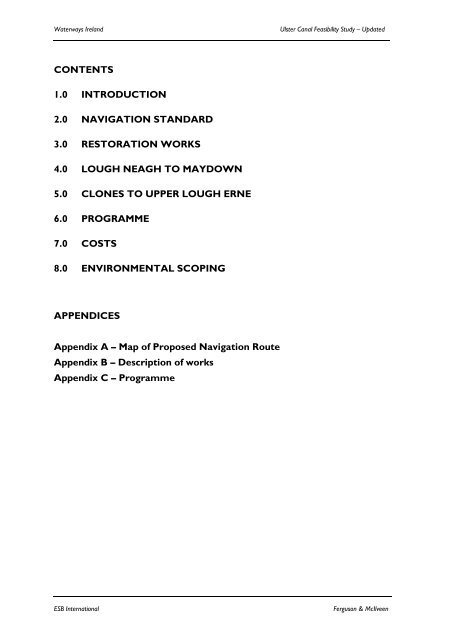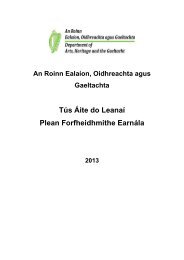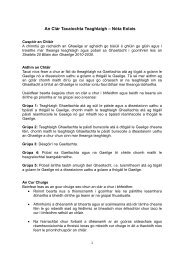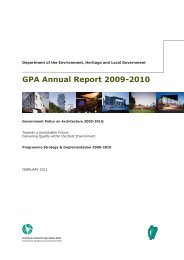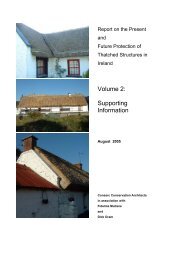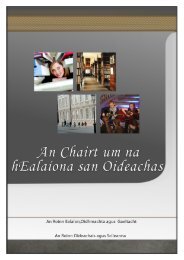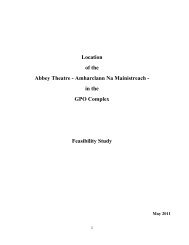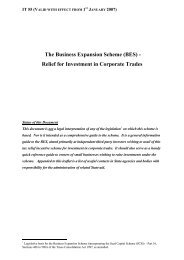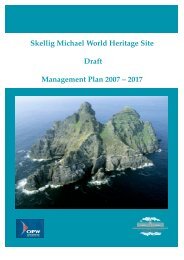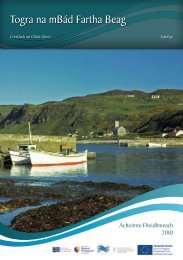Reopening of Ulster Canal
Reopening of Ulster Canal
Reopening of Ulster Canal
Create successful ePaper yourself
Turn your PDF publications into a flip-book with our unique Google optimized e-Paper software.
Waterways Ireland<strong>Ulster</strong> <strong>Canal</strong> Feasibility Study – Updatedwould connect into Drumully Lough. A new channel would cross the Cavan to Clones Roadinto Lough Sarah and subsequently into the River Finn downstream <strong>of</strong> Wattle Bridge. Thiswould prevent the necessity <strong>of</strong> undertaking works at Gortnacarrow and Wattle Bridges, both<strong>of</strong> which are <strong>of</strong> major heritage interestPresent ConditionApproximately 60% <strong>of</strong> the original canal route is intact. The dimensions <strong>of</strong> the canal arestandard throughout most <strong>of</strong> its length, with an approximate bed width <strong>of</strong> 6m. The originalcanal bridges are generic in construction, typically a single span masonry arch with an integraltowpath ledge underneath. There are 56 original masonry arch bridges intact along thenavigation with an additional 50 new crossings. The four aqueducts along the canal are extantand in good order.Geological analysis reveals that the original route <strong>of</strong> the <strong>Ulster</strong> <strong>Canal</strong> was chosen as theoptimum route and followed a line which used the most level terrain thus avoiding theconstruction <strong>of</strong> locks, while remaining in firm ground, thus avoiding piling etc.Navigation StandardThe 1998 feasibility study included a survey <strong>of</strong> river craft to facilitate the development <strong>of</strong>suitable navigational standards. The recommended standard for the <strong>Ulster</strong> <strong>Canal</strong>, which takesthese survey results into account, provides for a 11m surface water width and 6m wide locks.The standards have been selected to allow users <strong>of</strong> the <strong>Ulster</strong> <strong>Canal</strong> the flexibility to use theadjacent waterways viz. Bann, Shannon and Erne Navigation Systems, and the Shannon-ErneWaterway.Following the consideration <strong>of</strong> three options, the recommendation was made in previousstudies that the reopening <strong>of</strong> the canal should be with a 13m surface water width, 8m basewidth and 6m wide locks consistent with the dimensions <strong>of</strong> the adjacent waterways; the workcould take advantage <strong>of</strong> a route incorporating greater river usage which would provide anopportunity to bypass a number <strong>of</strong> the original locks and preserve them as permanent heritagefeatures.ESB International 2 Ferguson & McIlveen LLP
Waterways Ireland<strong>Ulster</strong> <strong>Canal</strong> Feasibility Study – UpdatedEnvironmental IssuesNatural HeritageThe proposal to re-open and re-use the <strong>Ulster</strong> <strong>Canal</strong> is generally in accordance with the aims<strong>of</strong> the policies and designations contained within the various development plans for the areasconcerned.A range <strong>of</strong> mitigating measures is proposed which includes relocation and compensation,construction <strong>of</strong> new accommodation bridges to access severed lands, the use <strong>of</strong> sediment trapsduring dredging to protect aquatic fauna, the re-use <strong>of</strong> excavated soil on other parts <strong>of</strong> thecanal and the introduction <strong>of</strong> new planting schemes which would regenerate and improvenatural habitats in addition to providing screening.The issues related to ecology address species and sites <strong>of</strong> conservation interest which have thepotential to be impacted, the possibility <strong>of</strong> transfer <strong>of</strong> nuisance/alien species between LoughErne and Lough Neagh and design measures for water quality and spoil disposal. Mitigationmeasures including costs are included in the proposals as appropriate.If the project were to proceed beyond feasibility stage, a full environmental impact assessmentwould be necessary, including establishing baseline survey data.Built HeritageThe canal is an invaluable heritage and cultural resource, as it formed an intrinsic part <strong>of</strong> thedevelopment <strong>of</strong> the localities through which it passed. Local landowners pushed for itsconstruction in an attempt to improve commercial trade links, and politicians agreed that itwould provide much needed employment for the people <strong>of</strong> rural north central Ireland, so many<strong>of</strong> whom had left to seek work in England and Scotland. Furthermore, the <strong>Ulster</strong> <strong>Canal</strong>, whichwas designed by John Killaly and Thomas Telford, has long been infamous as the narrowestgauge navigation in all <strong>of</strong> Ireland and is therefore <strong>of</strong> particular industrial heritage interest.The intention would be to repair and reinstate the appearance <strong>of</strong> the 19th Century featuresusing modern engineering and construction techniques to ensure durable and watertightstructures. Where original masonry arch bridges, culverts and aqueducts exist, it is intendedthat they would be incorporated into the reopened canal with minimum alterations. In orderto achieve sufficient width and headroom, it would be necessary to remove the towpath and tolower the bed marginally in places.ESB International 3 Ferguson & McIlveen LLP
Waterways Ireland<strong>Ulster</strong> <strong>Canal</strong> Feasibility Study – UpdatedAmong the options that could be considered are an operational bypass lock, rewatering a lockin isolation and restoring a lock in the dry where these would be feasible. There are manyother structures such as lock keepers’ cottages, canal stores, etc., along the length <strong>of</strong> the canalwhich have been recognised for their heritage value. These should be protected and sensitivelyrestored where possible to preserve this heritage value and to enhance the visualattractiveness <strong>of</strong> the finished canal product.Water ManagementShortage <strong>of</strong> water supply was one <strong>of</strong> the main factors which brought about the demise <strong>of</strong> theoriginal navigation. Historically, the water supply to the summit level <strong>of</strong> the <strong>Ulster</strong> <strong>Canal</strong> camefrom a small natural lake, Quig Lough, which was enlarged by the provision <strong>of</strong> a low dam toincrease its capacity. After the canal closed, the embankment at Quig Lough was removed andat present only a small natural lake remains. The area formerly flooded by the largerimpoundment has reverted to agricultural pasture.The reinstatement <strong>of</strong> Quig Lough would not on its own provide a solution to a restored canalwater requirement. It is considered that the benefits would not justify the significant cost andlikely problems associated with reinstatement <strong>of</strong> the Quig Lough Reservoir and the diversion <strong>of</strong>waters out <strong>of</strong> the Monaghan Blackwater. For the phase 1 works it is recommended that lowlift pumping be provided from the River Finn and River Blackwater.The necessity to achieve a watertight canal is fully recognised and the provision <strong>of</strong> watertightlocks and modern gate technology is considered essential, rather than the traditional leakagecontrol systems. Based on consultations with local and international tour operators, it isconsidered that the provision <strong>of</strong> automatically operated locks, using the most moderntechnology, would also make the navigation system more attractive and user friendly to boatusers.It is proposed that any restoration scheme would, with very limited exceptions, be carried outin such a manner that the existing drainage is maintained. Where necessary, diversion <strong>of</strong> drains,the construction <strong>of</strong> new culvert crossings and the provision <strong>of</strong> side drains would beundertaken.ESB International 4 Ferguson & McIlveen LLP
Waterways Ireland<strong>Ulster</strong> <strong>Canal</strong> Feasibility Study – UpdatedCostsThe estimated costs (January 2006 prices in Pounds Sterling) for the initial implementation <strong>of</strong>the two reaches are summarised as follows:-DescriptionErne-Clones£STGmNeagh-Maydown£STGmTotal£STGmTotal Capital Cost 18.570 9.320 27.890Total Non-Capital cost 5.200 2.970 8.170TOTAL 23.770 12.290 36.060Project TimescaleA six year implementation programme is considered the minimum period for the reopening <strong>of</strong>the two reaches <strong>of</strong> the <strong>Ulster</strong> <strong>Canal</strong> with the following milestones:• EIS, Planning, Heritage Year 1• Land Acquisition Years 1 and 2• Design and Procurement Years 2 and 3• Construction Years 3, 4, and 5• Commissioning Years 5 and 6• Marketing Years 5 and 6• Two sections <strong>of</strong> navigation open to users Summer Year 6ESB International 5 Ferguson & McIlveen LLP
Waterways Ireland<strong>Ulster</strong> <strong>Canal</strong> Feasibility Study – Updated1.0 INTRODUCTIONThe <strong>Ulster</strong> <strong>Canal</strong> as it stands is a valuable asset <strong>of</strong> immense cultural and historical significance.It forms part <strong>of</strong> an extensive navigation network which was constructed in Ireland in the 18thand 19th centuries. On reaching the 21st century, it is still possible to experience directly thecanal era by travelling on many parts <strong>of</strong> this system.The connected network extends from Waterford to Limerick and from there, northwards tothe Erne at Enniskillen and Belleek.The possibility <strong>of</strong> reopening the <strong>Ulster</strong> <strong>Canal</strong> is the most important <strong>of</strong> all possible extensionsto the present system <strong>of</strong> navigation. It would bring the network northwards where there issubstantial potential for promotion <strong>of</strong> heritage and economic growth and it would open up amajor part <strong>of</strong> the original system which now lies derelict. The benefits would comprise notonly the direct and indirect returns to the present navigation system, but also the potential forfuture returns from further navigation developments in Northern Ireland at Lough Neagh, theLagan <strong>Canal</strong> and the Newry <strong>Canal</strong>.1.1 HistoryThe <strong>Ulster</strong> <strong>Canal</strong> was opened in 1841, having been constructed at a total cost <strong>of</strong> £230,000.Traffic failed to develop due to technical difficulties primarily associated with an inadequatewater supply and the narrow width <strong>of</strong> the locks. The inadequate water supply was apparentfrom the start particularly west <strong>of</strong> Clones where it was found impossible to maintain waterlevels. The smallest lock which was only 3.6m wide and the narrowest lock in the countrymeant that many <strong>of</strong> the boats from the other <strong>Ulster</strong> navigations could not pass through it. Thecanal was operated by the <strong>Ulster</strong> <strong>Canal</strong> Company but they incurred severe losses in the earlyyears as they grappled with water losses and embankment repair.Despite a programme <strong>of</strong> improvement works including the building <strong>of</strong> a six metre high dam atQuig Lough the problems persisted and the canal continued to show a loss.In 1888, the canal was transferred to the Lagan Navigation Company. Competition from therailways affected traffic, the canal was generally navigable only from Lough Neagh to Monaghanand by the turn <strong>of</strong> the century, it was in serious decline. The last trading boat used the canal in1929 and two years later after much legal wrangling and local opposition it was closed <strong>of</strong>ficially.The asset value <strong>of</strong> the <strong>Ulster</strong> <strong>Canal</strong> has diminished since it has not been maintained forgenerations; many stretches <strong>of</strong> the canal have been filled in and locks and bridges have beenremoved. There is a real danger that the canal will be lost altogether if this situation is allowedESB International 6 Ferguson & McIlveen LLP
Waterways Ireland<strong>Ulster</strong> <strong>Canal</strong> Feasibility Study – Updatedto continue, hence reopening constitutes a conservation exercise, in addition to its role in thesocio-economic development <strong>of</strong> the region.1.2 Present BriefIn December 2005, Waterways Ireland commissioned a technical summary study from ESBInternational and Ferguson, with the following aim and brief:Aim“To draw up a technical summary report regarding the reopening <strong>of</strong> the <strong>Ulster</strong> <strong>Canal</strong> from LoughNeagh via the River Blackwater (to connect to the <strong>Ulster</strong> <strong>Canal</strong> in the vicinity <strong>of</strong> Blackwatertown) andfrom Lough Erne to Clones.This report should draw to the greatest extent possible on previous reports and summarize the currentposition on the issues and the costs.”Brief“Review and summarise the existing feasibility studies and the work proposed over the reaches fromLough Neagh via the River Blackwater (to connect to the <strong>Ulster</strong> <strong>Canal</strong> in the vicinity <strong>of</strong>Blackwatertown) and from Lough Erne to Clones.The report should indicate the works required over the reaches concerned, update the costs to currentfigures and comment on the physical, environmental and planning issues which could be encounteredshould works on these sections be undertaken.The report should indicate time frames relative to an implementation programme.This study should view the opening <strong>of</strong> the above sections <strong>of</strong> the canal as part <strong>of</strong> a phased approach toreopening the <strong>Ulster</strong> <strong>Canal</strong>.”In the previous studies, consultations were held with a wide range <strong>of</strong> interested parties. Thesewere held at a number <strong>of</strong> levels, ranging from meetings with individual landowners, to publicmeetings with representative groups. No additional consultations were held during thepreparation <strong>of</strong> this technical summary report. The site was not inspected and this report doesnot allow for any changes along the route since the previous inspections.ESB International 7 Ferguson & McIlveen LLP
Waterways Ireland<strong>Ulster</strong> <strong>Canal</strong> Feasibility Study – UpdatedDuring the preparation <strong>of</strong> this report, a separate socio-economic assessment wascommissioned by Waterways Ireland from PriceWaterhouseCoopers and TourismDevelopment Ireland.1.3 Recent StudiesESB International, in conjunction with Ferguson McIlveen, PriceWaterhouseCoopers, andTourism Development Ireland, was commissioned to undertake a feasibility study into therestoration <strong>of</strong> the <strong>Ulster</strong> <strong>Canal</strong> in May 1997.The key components <strong>of</strong> the study were:• An engineering study which examines all <strong>of</strong> the technical issues and arrives at a reliableconstruction procedure and cost estimate for the development.• An economic appraisal based on a realistic analysis, with clear recommendations that arerealisable in the short to medium term.• Environmental scoping to identify significant impacts and features <strong>of</strong> historic interest.The findings <strong>of</strong> this study were incorporated into the report entitled “A Feasibility Study intothe <strong>Reopening</strong> <strong>of</strong> the <strong>Ulster</strong> <strong>Canal</strong>” which was issued in June 1998.In May 2000, Waterways Ireland commissioned the ESB International, in conjunction withFerguson McIlveen to update the 1998 report addressing the following issues:• Update costs to January 2000 figures.• Inspect the canal and the riverine sections linking the canal to Lough Erne and LoughNeagh and report on any recent developments along its length, which have a bearing on reopening.Consider also planned developments in the area.• Assessment <strong>of</strong> lock operating systems – fully automatic and traditional swing beam method.• Produce a detailed implementation programme and critical path, taking into account allpreliminaries including legislation, approvals, environmental impact assessment, landacquisition etc.• Produce annual cash flow expenditure, accounting for inflation in the period.• Review the estimated benefits, particularly in the light <strong>of</strong> the evaluation <strong>of</strong> the ShannonErne Waterway economic out-turn (IFI Annual Report 1998) and recent waterwaystourism conditions.• Update the economic analysis.ESB International 8 Ferguson & McIlveen LLP
Waterways Ireland<strong>Ulster</strong> <strong>Canal</strong> Feasibility Study – UpdatedIn addition, Waterways Ireland commissioned the project team in 2001 to undertake afeasibility study into:(a) Extending the navigation on Lough Neagh to Milltown in Co. Armagh(b) Extending the navigation on the Erne system to Clones in Co. Monaghan.The present brief incorporates both the 1998 Feasibility Study and the results <strong>of</strong> the updatedinvestigations.PREVIOUS REPORTSA Feasibility Study into the <strong>Reopening</strong> <strong>of</strong> the <strong>Ulster</strong> <strong>Canal</strong>, 1998A Feasibility Study into the <strong>Reopening</strong> <strong>of</strong> the <strong>Ulster</strong> <strong>Canal</strong>, Updated 2001A Feasibility Study for Opening the Stretch from Lough Neagh to Milltown and from UpperLough Erne to Clones, June 2001SUPPLEMENTARY REPORTS1. <strong>Ulster</strong> <strong>Canal</strong> Condition Survey – Issued June 19982. Site Investigations – Issued June 19983. Navigation Study – Issued June 19984. Schedule <strong>of</strong> Navigation Works – Issued June 19985. Economic Appraisal – Reissued June 20016. Benefit Assessment – Issued June 19987. <strong>Ulster</strong> <strong>Canal</strong>: Plans and Long-sections – Issued June 19988. <strong>Ulster</strong> <strong>Canal</strong>: Surveyed Cross-sections – Issued June 19989. Automatic Lock System – Issued June 200110. Phased Opening – Issued June 2001Table 1.1 List <strong>of</strong> Previous ReportsESB International 9 Ferguson & McIlveen LLP
Waterways Ireland<strong>Ulster</strong> <strong>Canal</strong> Feasibility Study – Updated2.0 NAVIGATION STANDARDAs part <strong>of</strong> the structural and engineering assessment undertaken in the 1998 feasibility report,navigational standards were examined in respect <strong>of</strong> such issues as depth and width <strong>of</strong> channel,lock dimensions and navigation headroom at bridges etc.A survey <strong>of</strong> river craft in the study area was undertaken to facilitate the development <strong>of</strong>suitable navigational standards. This survey complements the data gathered for a similar surveywhich was carried out in 1989 as part <strong>of</strong> the Shannon-Erne Waterway Project.The recommended standard for the <strong>Ulster</strong> <strong>Canal</strong>, which takes the survey results into account,is similar to that adopted on the Shannon-Erne Waterway. The standards have been selectedto allow users <strong>of</strong> the <strong>Ulster</strong> <strong>Canal</strong> the flexibility to use the adjacent waterways viz. BannNavigation, Shannon and Erne systems, Shannon Erne Waterway.It is proposed to provide a minimum water depth <strong>of</strong> 1.55 metres in the canal which allows adepth <strong>of</strong> 0.35m for squat, deposit <strong>of</strong> sediment and weed growth. A beam width <strong>of</strong> 3.5m hasbeen adopted as representing the majority <strong>of</strong> boats. Based on this figure and allowing formanoeuvring clearances between boats, it is recommended that the canal be designed, wherepossible, with an 8m base width and a 13 m surface water width.It is recommended that all bridges should provide for a minimum navigation clearance <strong>of</strong> 3.5mover a 3m width.The proposed size <strong>of</strong> lock chamber is 26 metres long by 6 metres wide.The study takes into consideration two major re-routings at either end <strong>of</strong> the canal.2.1 Execution <strong>of</strong> Navigation ProposalsA detailed assessment <strong>of</strong> the necessary works required to bring the <strong>Ulster</strong> <strong>Canal</strong> back intooperation has been carried out. This section describes the nature <strong>of</strong> the works to beundertaken along the entire length. Sections 4 and 5 below describe the specific works to becarried out along the two specified reaches as follows:(1) Lough Neagh to Maydown(2) Clones to Upper Lough ErneESB International 10 Ferguson & McIlveen LLP
Waterways Ireland<strong>Ulster</strong> <strong>Canal</strong> Feasibility Study – Updated3.0 RESTORATION WORKS3.1 Reconstruction <strong>of</strong> <strong>Canal</strong> to an Increased WidthThe canal would be constructed to the pr<strong>of</strong>ile to a base width <strong>of</strong> 8 metres and a correspondingwater surface width <strong>of</strong> 13 metres.There is a large number <strong>of</strong> masonry arch bridges along the navigation, most <strong>of</strong> which are inreasonable condition and would require relatively minor remedial works. The majority <strong>of</strong> thesebridges do not meet the required standard for navigation width and a significant number do notmeet the standard for headroom clearance. In order to retain these bridges, it is recommendedthat the towpath be removed under the bridges and that some sections <strong>of</strong> the waterway belowered and the bridges underpinned.Because <strong>of</strong> the alterative route at either end <strong>of</strong> the canal it is possible to bypass several existinglocks e.g. Charlemont lock and Blackwatertown lock and retain these locks in their presentcondition as historical heritage features.3.2 New LocksNew lock chambers would either be constructed in reinforced concrete or sheet piling withashlar facing above water level. In poor ground and particularly in wet conditions, the use <strong>of</strong>sheet piling would have considerable advantages during the construction stage.The dimensions <strong>of</strong> the lock would be 6m wide x 26m long. Each chamber would be fitted withmitre gates <strong>of</strong> composite construction i.e. a main structure <strong>of</strong> steel with hardwood heels andmitre posts and cill clappings. The gate cills would be constructed in reinforced concrete.The lock would be filled and emptied by a suitable sluice system. Prefabricated traditionalarrangements with modern penstocks should be installed to reduce maintenance.Railed walkways should be fitted to the upstream side <strong>of</strong> the gates to provide access to theoperating gear.Ancillaries would include landing stages, walkways, paved scorting rings, ladders (4 Nominimum), service footbridge, mooring bollards and areas <strong>of</strong> hard paving as described above.ESB International 11 Ferguson & McIlveen LLP
Waterways Ireland<strong>Ulster</strong> <strong>Canal</strong> Feasibility Study – UpdatedConsultations with local and international tour operators indicated that the projected benefits<strong>of</strong> reopening the canal are closely linked to the needs <strong>of</strong> the international holidaymaker.Experience in other countries, most notably France, has highlighted the preference forautomatic operating systems where a canal has a large number <strong>of</strong> locks. The adjoining Bann,Shannon and Erne Navigations have very few locks and hence modern technology at the 26locks on the <strong>Ulster</strong> <strong>Canal</strong> would make the system more attractive as a destination in its ownright.Therefore, it is proposed that the gates and sluice system would be operated using an electrohydraulicsystem controlled by the boat user either from a push button panel on the bank orpossibly from the boat itself when it is in the lock. Each control system would be linked byradio to a monitoring station.3.3 Existing Masonry Arch Navigation BridgesThere are a significant number <strong>of</strong> existing masonry arch bridges along the Blackwatertown toMaydown and Clones to River Finn sections <strong>of</strong> the navigation. The majority <strong>of</strong> these bridgesare in reasonable condition and would require only minor remedial works. The proposedtypes <strong>of</strong> remedial works range from cleaning and pointing <strong>of</strong> masonry (Type A) to majorstrengthening and underpinning works (Type D).Remedial Works Type AThis form <strong>of</strong> remedial work applies to bridges where abutments, parapets etc. are structurallysound. All that is required in this case is the cleaning and pointing <strong>of</strong> masonry.Remedial Works Type BIn this case, the towpath would be removed under the bridge to increase the navigationalchannel width to approximately 6 m. A new base slab would be constructed in concrete toprevent scouring and the masonry cleaned and pointed.Remedial Works Type CRemedial works would involve grouting <strong>of</strong> the fill material behind abutments to strengthen theabutments, removal <strong>of</strong> towpath, construction <strong>of</strong> new base slab and general cleaning andpointing <strong>of</strong> masonry.ESB International 12 Ferguson & McIlveen LLP
Waterways Ireland<strong>Ulster</strong> <strong>Canal</strong> Feasibility Study – UpdatedRemedial Works Type DAs C above but also including for underpinning <strong>of</strong> abutments.3.4 New BridgesIt is envisaged that all new road and accommodation bridges would be constructed inreinforced concrete. The exact position and form <strong>of</strong> each structure would depend on a range<strong>of</strong> factors including bridge category, span, foundation conditions, associated embankmentworks, road realignment etc. which are particular to each location.The ‘road’ bridges would be subject to the requirements <strong>of</strong> the relevant Roads Authority t<strong>of</strong>acilitate adoption.It is essential that the detailing and finishes, particularly for those visible from the water, aresympathetic with the existing navigation and all should be finished in masonry or other suitablecladding.ESB International 13 Ferguson & McIlveen LLP
Waterways Ireland<strong>Ulster</strong> <strong>Canal</strong> Feasibility Study – Updated4.0 LOUGH NEAGH TO MAYDOWNThe original line <strong>of</strong> the <strong>Canal</strong> linked into the <strong>Ulster</strong> Blackwater at Charlemont. A survey <strong>of</strong> theBlackwater River from Charlemont to Blackwatertown was carried out to determine thefeasibility <strong>of</strong> utilising the river as part <strong>of</strong> the restored navigation. This would remove thenecessity <strong>of</strong> restoring approximately 3.5km <strong>of</strong> the original canal between Blackwatertown andCharlemont and the requirement for 4 new road bridges and 6 new accommodation bridgesalong this stretch.Moorings and dredging works would be required at the Maghery Cut. The river section alongthe Blackwater from the Maghery Cut at Lough Neagh to Blackwatertown is 19520 m long andit already has sufficient depth for navigation.The only obstruction upstream <strong>of</strong> Maghery is the M1Motorway Bridge which has inadequatenavigational headroom. A new channel would be constructed adjacent to the river under themotorway with increased headroom to meet navigational standards.The navigation would follow the River Blackwater to its junction with the Ballymartrim River.The navigation would then follow the line <strong>of</strong> the Ballymartrim River to connect into the originalcanal at chainage 19920 m, close to Mullylegan Bridge.The river channel would be deepened and widened to provide the required width. Two newlocks would be constructed upstream <strong>of</strong> Point Bridge.Upstream <strong>of</strong> Atkinson’s Bridge to Maydown the existing canal would be widened to providethe required width and lowered by 0.3m.Accommodation bridges would be required at three locations to replace low level accesses todwellings and laneways. Remedial works, which include the removal <strong>of</strong> the towpath, would benecessary at 4 original arch bridges.The navigation would terminate at Maydown Bridge at Chainage 23500 m from Lough Neaghand the overall length would be made up at follows:• Lough Neagh to Ballymartin River/ Blackwater confluence 19.50 km• Confluence to original canal 0.40 km• Original <strong>Canal</strong> to Maydown Bridge 3.6 kmESB International 14 Ferguson & McIlveen LLP
Waterways Ireland<strong>Ulster</strong> <strong>Canal</strong> Feasibility Study – Updated5.0 CLONES TO UPPER LOUGH ERNEThe reach from the Clones to the Erne System is approximately 11.5km.The route would start west <strong>of</strong> Clones in the vicinity <strong>of</strong> the refurbished <strong>Canal</strong> stores.The <strong>Canal</strong> has been infilled for stretches along side the N54 road. The infilled channel wouldbe excavated to the specified dimensions and embankments provided where required. A series<strong>of</strong> low level crossings would be replaced by realigning and regrading the roads wherenecessary. At Munnilly (B94) and at Drumsloe (B101) moveable bridges would be required.Field accommodation bridges would be provided where re-excavation <strong>of</strong> the canal would causeseparation <strong>of</strong> land holdings.The <strong>Canal</strong> largely follows its original route from Clones to a point east <strong>of</strong> Gortnacarrow.The recommended route for the canal from this point to the Erne System, a distance <strong>of</strong> 3.5km,involves excavation <strong>of</strong> the canal along a new route to the River Finn upstream <strong>of</strong> DrumullyLough. The route would then exit Drumully Lough via a new channel which would cross theCavan to Clones Road and enter Lough Sarah and subsequently again into the River Finndownstream <strong>of</strong> Wattle Bridge. This would prevent the necessity <strong>of</strong> undertaking works atGortnacarrow and Wattle Bridges, both <strong>of</strong> which are <strong>of</strong> major heritage interest.A new bridge would be required at Derrykerrib to provide adequate clearance for the range <strong>of</strong>levels which occur on the River Finn.Remedial works would be carried out on the Lacky Aqueduct (A4).Mooring areas would be provided in a number <strong>of</strong> locations:• At Clones in close proximity to the refurbished <strong>Canal</strong> stores.• At a suitable location close to the River Finn and• Close to Drumsloe Lough Bridge (minor mooring)The final configuration <strong>of</strong> the route from Gortnacarrow to Lough Erne via Lough Sarah wouldbe subject to a detailed topographical survey and site investigation.ESB International 15 Ferguson & McIlveen LLP
Waterways Ireland<strong>Ulster</strong> <strong>Canal</strong> Feasibility Study – Updated6.0 PROGRAMMEA draft implementation programme has been prepared for the reopening <strong>of</strong> the two canalsections as outlined in Section 2 above. The programme, in Appendix C, is based on anassessment <strong>of</strong> the proposed works and the out-turn <strong>of</strong> the Shannon-Erne Waterway project.It is proposed to implement the reopening <strong>of</strong> both sections simultaneously.A six year programme is considered to be the minimum implementation period with thefollowing milestones:• EIS, Planning, Heritage Year 1• Land Acquisition Years 1 and 2• Design and Procurement Years 2 and 3• Construction Years 3, 4, and 5• Commissioning Years 5 and 6• Marketing Years 5 and 6• Two sections <strong>of</strong> navigation open to users Summer Year 6ESB International 16 Ferguson & McIlveen LLP
Waterways Ireland<strong>Ulster</strong> <strong>Canal</strong> Feasibility Study – Updated7.0 COSTS7.1 Capital CostsEstimates <strong>of</strong> cost (January 2006) for the restoration <strong>of</strong> two reaches <strong>of</strong> the <strong>Ulster</strong> <strong>Canal</strong> arepresented in this section.In general, the cost estimates are based on similar work on projects undertaken by theconsultants and in particular on those rates which applied to the Shannon-Erne WaterwayProject. All costs are given in Sterling at 2006 rates.The capital cost estimates are summarised in Table 7.1 and are based on the schedule onworks set out in Appendix B.The estimated capital costs are broken down into the following categories and are based onthe following assumptions.Mobilisation / Site ClearanceThis involves the removal <strong>of</strong> trees, heavy scrub and other obstructions in order to allowexcavation equipment access to the canal. It also includes for the construction <strong>of</strong> temporaryhaul roads to areas not adjacent to public roads.EarthworksThe extent <strong>of</strong> earthworks was determined from comparison <strong>of</strong> the existing channel with thatproposed. Bank slopes <strong>of</strong> 1 Vertical: 1.5 Horizontal would to be provided in most areas. Inlocations which might be prone to bank slips, flatter slopes or other bank stabilising measureswould be undertaken.The material to be excavated was classified as rock or s<strong>of</strong>t material based on site investigationresults, where available, and visual inspection. Excavated s<strong>of</strong>t material would be spread locallyor used for the construction <strong>of</strong> embankments. Rock would be removed to suitable spoil tipsor used for making access roads.Provision is made for stripping and storing topsoil from sufficient areas adjacent to the bankfrom which works would be carried out preferably on one side only. Once the excavatedmaterial in a suitable condition has been spread over the area from which the topsoil has beenremoved, the topsoil would be re-spread and re-seeded.ESB International 17 Ferguson & McIlveen LLP
Waterways Ireland<strong>Ulster</strong> <strong>Canal</strong> Feasibility Study – UpdatedLocksA total <strong>of</strong> 4 new wider locks would be constructed. The aesthetic appearance <strong>of</strong> all lockswould be maintained by using stonework in areas which would be visible above the designwater levels. Two mooring facilities would be provided for boats waiting to use the lock, oneupstream and one downstream. Allowance has been made for new gates and lock furniture.Provision is made for the installation <strong>of</strong> an automatic operating system.Pumped Water SupplyPumps would be to provided at all locks to pump water from the Finn and the Blackwater. Theinstallation <strong>of</strong> each pump would involve the construction <strong>of</strong> a pumphouse downstream <strong>of</strong> thelock and the laying <strong>of</strong> pipework to the higher level.BridgesThe headroom to be provided under bridges is to be 3.5 metres. Where it is necessary toreplace an existing bridge, a minimum navigational headroom <strong>of</strong> 3.5 metres would be provided.There are a number <strong>of</strong> low level crossings <strong>of</strong> the canal and a cost estimate <strong>of</strong> providing a newbridge at each <strong>of</strong> these locations has been made. Where possible, sufficient headroom wouldbe achieved by regrading and/or realigning the approach road. Where this is not feasible orthe costs would be excessive, allowance is made for the provision <strong>of</strong> a moveable bridge.Most <strong>of</strong> the original arch bridges along the canal would provide adequate headroom. Remedialworks <strong>of</strong> different degrees would be carried out at each bridge depending on its presentcondition. In general, the remedial works would consist <strong>of</strong> cleaning, pointing, grouting andother minor works. The removal <strong>of</strong> the towpaths would increase the width under the bridgesfrom 4m to approximately 6m.AqueductsThe existing aqueducts would be retained. Remedial works to ensure their watertightnesswould be undertaken. The survey indicated that the depth <strong>of</strong> water over the masonry base onthe aqueducts was more than 2m. This provided scope for lining the base with an impermeableclay. Desilting <strong>of</strong> the aqueducts is proposed with an impermeable concrete layer being used toensure watertightness. This would also facilitate the lowering <strong>of</strong> cill levels on reaches withaqueducts.ESB International 18 Ferguson & McIlveen LLP
Waterways Ireland<strong>Ulster</strong> <strong>Canal</strong> Feasibility Study – UpdatedMooringsAn all-in sum is provided for the construction <strong>of</strong> mooring areas along the canal. This includesfor provision <strong>of</strong> associated buildings with washroom, laundry, facilities for persons withdisabilities, pump-out facilities, etc. Moorings at Maghery, Blackwatertown and Gortnacarrowwould be provided.Drainage WorksProvision is made for necessary works on feeders to the canal and drains which are culvertedunder the canal. All existing culverts and feeders would be refurbished or reconstructed. Theexisting canal forms part <strong>of</strong> the drainage network in some locations and provision is made forside drains or new culverts under the canal in these instances.CompensationA number <strong>of</strong> businesses and residences would be directly affected by the restoration <strong>of</strong> thecanal. In each <strong>of</strong> these instances, a sum is provided to cover the necessary compensationcosts.ServicesThe reopening <strong>of</strong> the canal would impinge on a number <strong>of</strong> services including water mains andsewers. A lump sum is provided to cover the cost <strong>of</strong> relocating these services.<strong>Canal</strong> LiningIt might be necessary to provide special treatment at specific locations to restrict water loss. Asum is provided for lining some stretches <strong>of</strong> the canal with a proprietary lining fabric coveredwith concrete/clay in order to prevent this problem.TowpathAn access towpath for maintenance purposes would be provided on one bank. Fencing wouldbe required to protect the canal banks from damage by livestock, to prevent livestock strayinginto the canal, to provide access for maintenance and other activities and to define the landtake. This cost is included under earthworks.A separate all-in sum is provided for a 2m wide towpath. This includes for new crossingsacross streams and drains, the erection <strong>of</strong> stiles, gates and signage along its length.ESB International 19 Ferguson & McIlveen LLP
Waterways Ireland<strong>Ulster</strong> <strong>Canal</strong> Feasibility Study – UpdatedMiscellaneous WorksProvision is made for a range <strong>of</strong> miscellaneous works including fencing, public road repair,protection <strong>of</strong> walls, etc.7.2 Non Capital CostsThe non capital costs (January 2006) for the navigation project are presented Table 7.2 and thetotal costs in Table 7.3.7.3 Operation and MaintenanceThe overall annual operation and maintenance costs estimate is based on an assessment <strong>of</strong> theoperating experience on the Shannon-Erne Waterway and more particularly on stillwaternavigations such as the Grand <strong>Canal</strong>.It is envisaged that the management operation and maintenance would be the responsibility <strong>of</strong>Waterways Ireland. Waterway patrollers would be recommended for routine patrol andoperation, including one at each end to provide an introduction to the system for boaters.Maintenance crews would be responsible for weed cutting, spraying, cleaning debris from canal,bank repair, re-stabilising <strong>of</strong> banks by raising and widening, maintenance <strong>of</strong> feeders, leak repair,lock furniture repair, jetties, etc.Certain maintenance works might also be contracted out, such as grass cutting. Automaticlock operations and automatic service blocks would require a preventive maintenanceprogramme, most likely under a service contact. Three maintenance overhauls would probablybe undertaken each year. A communication system which relays information on gate openingsand water levels would be <strong>of</strong> considerable advantage to the operation and management <strong>of</strong> thesystem.A significant operating cost component would be associated with pumping in the summermonths.A grassed towpath would be a major advantage for ease <strong>of</strong> maintenance. A bitmac surface onthe towpath was considered for walkers, cyclists, anglers and others but this is not compatiblewith canal maintenance which involves heavy machinery. This surfacing is proposed only in andaround the towns and villages and a grassed surface with a central gravel section would beprovided along the remaining towpath. All drain crossings would be culverted.ESB International 20 Ferguson & McIlveen LLP
Waterways Ireland<strong>Ulster</strong> <strong>Canal</strong> Feasibility Study – UpdatedThe estimated annual cost for the Operation and Maintenance <strong>of</strong> the restored North Easternand South Western sections is STG £200,000.ESB International 21 Ferguson & McIlveen LLP
Waterways Ireland<strong>Ulster</strong> <strong>Canal</strong> Feasibility Study – UpdatedDescription Erne -Clones£STGmNeagh -Maydown£STGmTotal£STGmMobilisation/Site Clearance 0.170 0.190 0.360Earthworks 4.900 1.150 6.050Locks Refurbishment 0.000 0.000 0.000Reconstruction 1.940 1.940 3.880Pumped Water Supply 0.230 0.210 0.440Bridges New Road Bridges 4.060 0.000 4.060New Accommodation Bridge 1.440 0.380 1.820Moveable Bridges 2.000 0.000 2.000Remedial Works 0.200 0.200 0.400Aqueducts Remedial Works 0.110 0.000 0.110Moorings 1.030 0.370 1.400Drainage Works 0.210 0.100 0.310Compensation 0.350 0.040 0.390Relocation <strong>of</strong> Services 0.090 0.020 0.110<strong>Canal</strong> Lining 0.130 0.000 0.130Towpath 0.490 1.450 1.940Miscellaneous Works 1.220 0.190 1.410Extension <strong>of</strong> Maghery Cut 0.000 0.320 0.320Navigation Motorway Bridge 0.000 2.060 2.060to LoughBerthing at Lough Neagh 0.000 0.700 0.700NeaghTotal Cost <strong>of</strong> Capital Work18.570 9.320 27.890(contingencies included)Table7.1 Navigation Restoration - Estimate <strong>of</strong> Capital CostsNote:If the works along the River Blackwater, between Lough Neagh and Blackwatertown areexcluded, then the capital costs for the North Eastern section is reduced to £6.24 (STGm).ESB International 22 Ferguson & McIlveen LLP
Waterways Ireland<strong>Ulster</strong> <strong>Canal</strong> Feasibility Study – UpdatedTable7.2 Non-Capital Costs for RestorationThe total costs for restoration are summarised in Table 7.3DescriptionErne-Clones£STGmNeagh-Maydown£STGmTotal£STGmEnvironmental Impact Assessment 0.040 0.030 0.070Site Investigation 0.150 0.070 0.220Land Acquisition & Associated Fees 1.200 0.910 2.110Project Management 0.400 0.290 0.690Pr<strong>of</strong>essional Fees 1.600 0.830 2.430R.E. Costs 0.600 0.350 0.950Expenses 0.200 0.100 0.300Environmental & Heritage Supervision 0.030 0.020 0.050Marketing 0.680 0.370 1.050Special Survey at Lough Sarah 0.300 0.300Total Non-Capital Costs 5.200 2.970 8.170DescriptionErne-Clones£STGmNeagh-Maydown£STGmTotal£STGmTotal Capital Cost 18.570 9.320 27.890Total Non-Capital cost 5.200 2.970 8.170TOTAL 23.770 12.290 36.060Table 7.3 Total Estimated Cost <strong>of</strong> RestorationESB International 23 Ferguson & McIlveen LLP
Waterways Ireland<strong>Ulster</strong> <strong>Canal</strong> Feasibility Study – Updated8.0 ENVIRONMENTAL SCOPING8.1 IntroductionThe 1998 scoping study assessed the entire length <strong>of</strong> the navigation from Lough Neagh alongthe River Blackwater to where the canal starts at Charlemont and then continues until thecanal joins the Erne system in Fermanagh. Environmental Scoping is intended to provide afocus for environmental assessment by identifying the key issues <strong>of</strong> concern at an early stageand ensuring that they are subject to assessment at an appropriate level. If the projectproceeds there would be a full Environmental Assessment with public consultation. In additionto identifying areas <strong>of</strong> possible concern, scoping can also identify opportunities forenvironmental enhancement.To enable a fair assessment <strong>of</strong> the environmental issues associated with the project to takeplace, baseline conditions were established along the route using information available. Policyinformation was also reviewed. Further information was gathered through an extensiveconsultation exercise.Since the completion <strong>of</strong> the updated <strong>Ulster</strong> <strong>Canal</strong> Feasibility Study in 2001 there have beenseveral changes to Planning and Environmental Policies which would have implications for there-opening <strong>of</strong> the <strong>Ulster</strong> <strong>Canal</strong>.8.2 Planning PoliciesThe Draft Regional Strategic Framework for Northern Ireland has now been finalised andpublished as the Regional Development Strategy for Northern Ireland 2025. Policies andstrategies within that document would therefore need to be updated.Craigavon Area Plan has also been published as a final document (Craigavon Area Plan 2010),and therefore these polices need to be reviewed.8.3 Environmental PoliciesIt may be worth noting that EHS Natural heritage now normally request a Test <strong>of</strong> LikelySignificance, which assess the impact which a proposal may have on a European designated site,such as the SPA and Ramsar sites on Lough Neagh, and the SAC, SPA and Ramsar site onUpper Lough Erne.ESB International 24 Ferguson & McIlveen LLP
Waterways Ireland<strong>Ulster</strong> <strong>Canal</strong> Feasibility Study – UpdatedAlso, ASSI consent is required when developing within an ASSI.8.4 HeritageA schedule <strong>of</strong> listed buildings and Industrial archaeological sites are included in the 2001Feasibility Study.EHS should be contacted to ensure that no other Listed Buildings / Industrial heritage sites andArchaeological finds have been designated since 2001.ESB International 25 Ferguson & McIlveen LLP
APPENDIX AMap <strong>of</strong> Proposed Navigation Route
Appendix BDescription <strong>of</strong> works
DESCRIPTION OF WORKSA detailed assessment <strong>of</strong> the necessary works required to bring the <strong>Ulster</strong> <strong>Canal</strong> back intooperation was carried out as part <strong>of</strong> the original feasibility study. This appendix describesthe nature <strong>of</strong> the works to be undertaken at each structure along the proposed routes ateither end <strong>of</strong> the navigation.(1) River Blackwater to Maydown(2) Clones to the Finn RiverRiver Blackwater Section – Lough Neagh to Ballymartrim RiverChainageDescription <strong>of</strong> Worksm0-19520 Channel Works along River Blackwater between Lough Neagh andBallymartrim Drain.Bank clearance work will be required along the Blackwater River.0 - 250 Maghery CutPhase 1 Dredging works and refurbishment <strong>of</strong> jettiesPhase 2 New Marina6736 Motorway BridgeProvide adequate clearance for navigation17,963 Blackwatertown MooringsConstruct a new mooring near Blackwatertown Bridge.
Blackwater <strong>Canal</strong> Section- Ballymartrim River to Maydown BridgeChainageDescription <strong>of</strong> Worksm19520 Channel between entrance to canal and Maydown Bridge B13The navigation will follow the line <strong>of</strong> the Ballymartrim Drain which will bedeepened and widened to provide an 8 metre base width and will tie intothe canal at chainage 19920.Construct 2 new locks19,920 Connect to line <strong>of</strong> original navigation upstream <strong>of</strong> Mullyleggan Bridge21243 Bridge B10. Atkinson’s BridgeCarry out remedial works Type D.21853 Bridge B11. Tullymore Bridge (Road Bridge)Carry out remedial works Type D.22713 Bridge B12. Drumduff Bridge (Accommodation)Carry out remedial works Type D.23100 Accommodation BridgeConstruct new accommodation bridge.23500 Bridge B13. Maydown BridgeCarry out remedial works Type D.
Clones to River FinnChainagem77,250 to77,719Section 7.2 - Bridge B88 to Bridge B91Description <strong>of</strong> WorksChannel between Clones and Bridge B91• Excavate the channel to the original dimensions, base width 8.0m.• A double embankment will be located between Clones and BridgeB91.• Additional field accommodation bridges will be required in thecurrently filled stretches.• Due to the widening <strong>of</strong> the channel, the original towpath, wherepresent, will be removed and then reconstructed on the south bank.77,250 Clones Mooring AreaConstruct a new mooring area at Clones.77,562 Bridge B90. Low accommodation crossingRemove the low crossing and replace by a new accommodation bridge77,719 Bridge B91. Teehill Bridge (Accommodation)Carry out remedial works D.
Chainagem77,719 to79,449Section 7.3 - Bridge B91 to Bridge B95Description <strong>of</strong> WorksChannel between Bridge B91 and Bridge B95.• Excavate the channel to the original dimensions, base width 8.0m.• A double embankment will be located between Bridge B91 and BridgeB95.• Maintain the existing canal line at the Lacky Aqueduct by purchasingand removing the house built on the route.• Due to the widening <strong>of</strong> the channel, the original towpath, wherepresent, will be removed and then reconstructed on the south bank.77,991 Lacky AqueductCarry out remedial works. Extra costs will occur due to the widersection.78,116 Bridge B92. Clonfad low crossing (Accommodation)Remove the low crossing and replace by a new accommodation bridge78,619 Bridge B93. Low crossing (Accommodation)Remove the low crossing and compensate the land user.79,440 Bridge B94. Munnilly low crossing (County Road)Replace the low crossing by a moveable bridge at the same location.79,449 Bridge B95. Munnilly masonry bridge. Redundant.Refurbish the existing bridge for heritage purposes.
ChainageSection 7.4 - Bridge B95 to Bridge B98mDescription <strong>of</strong> Works79,449 to Channel between Bridge B95 and Bridge B98.81,417• Excavate the infilled channel to the original dimensions, base width8.0m.• A double embankment will be located between Bridge B95 and BridgeB98.• Due to the widening <strong>of</strong> the channel, the original towpath, wherepresent, will be removed and then reconstructed on the south bank.80,026 Bridge B96. Low accommodation crossing to a new house• Re-route the canal southwards to avoid the new house.• Realign the Lackey tributary affected by re-routing.80,320 Bridge B97. Clongowna low crossing (Accommodation)• Remove the low crossing and replace it by a new accommodationbridge.• Re-route the canal southwards to avoid the house.81,417 Bridge B98. Derrynure low crossing (Accommodation)• Remove the low crossing and replace it by a new accommodationbridge.• Ramp the farm lane leading to and from the bridge.
ChainageM81,417 to85,218Section 7.5 - Bridge B98 to Bridge B102Description <strong>of</strong> WorksChannel between Bridge B98 and Bridge B102• Excavate the channel to the original dimensions, base width 8.0m.• A double embankment will be located between Bridge B98 and BridgeB102.• Due to the widening <strong>of</strong> the channel, the original towpath, wherepresent, will be removed and then reconstructed on the south bank.82,269 Bridge B99. County Road Crossing (McMahon’s)Carry out remedial works D.83,299 Bridge B100. Drumsloe Lough Bridge (County Road)Carry out remedial works D.83,350 Drumsloe Mooring AreaConstruct a new mooring area near Drumsloe Lough Bridge84,076 Bridge B101. Drumsloe ‘Swing’ low crossing (County Road)Remove the low crossing and replace it by a moveable bridge.84,322 Culvert carrying a stream to Lakeview Lough.Construct new culvert due to the wider and deeper channel.85,218 Bridge B102. Low crossing (Accommodation)Remove the low crossing and replace it by a new accommodation bridge
New Route from Gortnacarrow to Derrykerrib.Chainagem0 to870Bridge B102 to River FinnDescription <strong>of</strong> WorksChannel between Bridge B102 and River Finn.• Excavate a channel having a base width <strong>of</strong> 8.0m.• Construct embankments on both sides for 70m at the start.70 New Lock.• Construct a new lock to lower the bed level from 47.5m to 44.5m.370 Minor Road to Drummully.• Construct a new bridge over the canal.• To provide adequate ramping to the new bridge, the road will beregraded and realigned. New access will be provided to any affectedproperties.720 New Lock.• Construct a new lock to lower the bed level from 44.5m to 41.65m forentry to the River Finn.
Chainagem870 to3,570Gortnacarrow to Derrykerrib via Lough SarahDescription <strong>of</strong> WorksChannel works between Gortnacarrow and Derrykerrib.• This entire stretch will have a bed level <strong>of</strong> 41.65m.• Excavate a 600m channel in the River Finn.• Excavate a new channel along a drain for 550m to Lough Sarah.• Excavate a channel for 300m in Lough Sarah.• Excavate a 150m long channel along the stream between Lough Sarahand the River Finn.• Excavate in the River Finn for 1,100m.1,670 A3/ N54 Clones to Cavan road.• Construct a bridge over the canal.• To provide adequate ramping to the new bridge, the road will beregraded and realigned. New access will be provided to any affectedproperties.3,500 Derrykerrib Bridge.• Construct a new bridge approximately 100m downstream <strong>of</strong> theexisting bridge.• Construct road sections to either side <strong>of</strong> the new bridge.• Remove the deck <strong>of</strong> the existing bridge.
Appendix CProgramme


